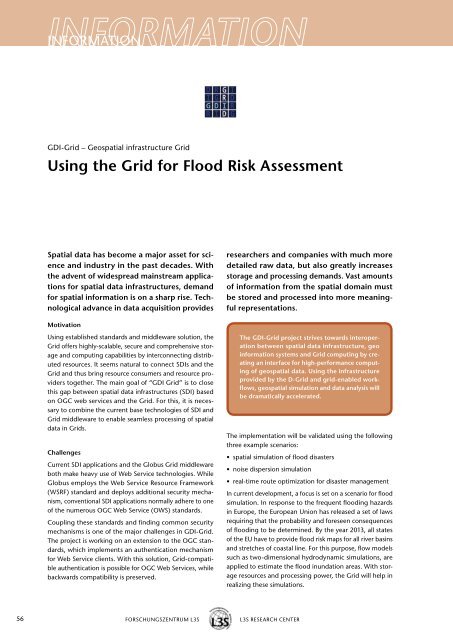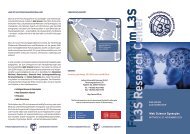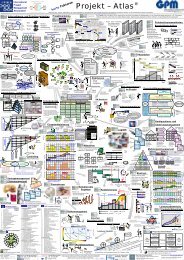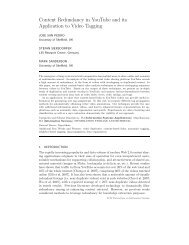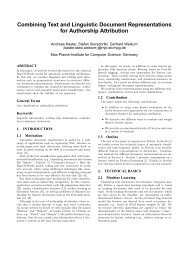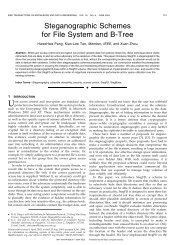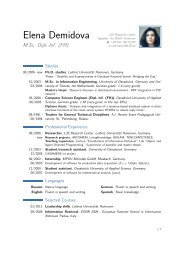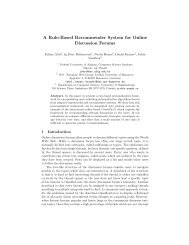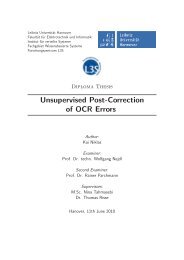knowledge · information · learning - Forschungszentrum L3S
knowledge · information · learning - Forschungszentrum L3S
knowledge · information · learning - Forschungszentrum L3S
Create successful ePaper yourself
Turn your PDF publications into a flip-book with our unique Google optimized e-Paper software.
56<br />
INFORMATION<br />
GDI-Grid – Geospatial infrastructure Grid<br />
using the grid for Flood Risk Assessment<br />
Spatial data has become a major asset for science<br />
and industry in the past decades. With<br />
the advent of widespread mainstream applications<br />
for spatial data infrastructures, demand<br />
for spatial <strong>information</strong> is on a sharp rise. Technological<br />
advance in data acquisition provides<br />
Motivation<br />
Using established standards and middleware solution, the<br />
Grid offers highly-scalable, secure and comprehensive storage<br />
and computing capabilities by interconnecting distributed<br />
resources. It seems natural to connect SDIs and the<br />
Grid and thus bring resource consumers and resource providers<br />
together. The main goal of “GDI Grid” is to close<br />
this gap between spatial data infrastructures (SDI) based<br />
on OGC web services and the Grid. For this, it is necessary<br />
to combine the current base technologies of SDI and<br />
Grid middleware to enable seamless processing of spatial<br />
data in Grids.<br />
Challenges<br />
Current SDI applications and the Globus Grid middleware<br />
both make heavy use of Web Service technologies. While<br />
Globus employs the Web Service Resource Framework<br />
(WSRF) standard and deploys additional security mechanism,<br />
conventional SDI applications normally adhere to one<br />
of the numerous OGC Web Service (OWS) standards.<br />
Coupling these standards and finding common security<br />
mechanisms is one of the major challenges in GDI-Grid.<br />
The project is working on an extension to the OGC standards,<br />
which implements an authentication mechanism<br />
for Web Service clients. With this solution, Grid-compatible<br />
authentication is possible for OGC Web Services, while<br />
backwards compatibility is preserved.<br />
FORSCHUNGSZENTRUM <strong>L3S</strong> <strong>L3S</strong> RESEARCH CENTER<br />
researchers and companies with much more<br />
detailed raw data, but also greatly increases<br />
storage and processing demands. vast amounts<br />
of <strong>information</strong> from the spatial domain must<br />
be stored and processed into more meaningful<br />
representations.<br />
The gDI-grid project strives towards interoperation<br />
between spatial data infrastructure, geo<br />
<strong>information</strong> systems and grid computing by creating<br />
an interface for high-performance computing<br />
of geospatial data. using the infrastructure<br />
provided by the D-grid and grid-enabled workflows,<br />
geospatial simulation and data analysis will<br />
be dramatically accelerated.<br />
The implementation will be validated using the following<br />
three example scenarios:<br />
• spatial simulation of flood disasters<br />
• noise dispersion simulation<br />
• real-time route optimization for disaster management<br />
In current development, a focus is set on a scenario for flood<br />
simulation. In response to the frequent flooding hazards<br />
in Europe, the European Union has released a set of laws<br />
requiring that the probability and foreseen consequences<br />
of flooding to be determined. By the year 2013, all states<br />
of the EU have to provide flood risk maps for all river basins<br />
and stretches of coastal line. For this purpose, flow models<br />
such as two-dimensional hydrodynamic simulations, are<br />
applied to estimate the flood inundation areas. With storage<br />
resources and processing power, the Grid will help in<br />
realizing these simulations.


